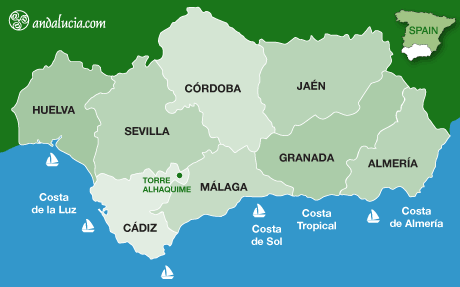
Torre Alhamique's name comes from the Arabic "the wise" or "the learned" © Michelle Chaplow |
|
TORRE ALHAQUIME - HISTORY AND MONUMENTS
This pretty white town in the Sierra de Cadiz dates from Muslim times; it closely resembles Berber towns in the hills of north Africa. Torre Alhamique's name comes from the Arabic Al Hakin family, meaning "the wise" or "the learned". This family owned the tower-fortress, located 4km from Olvera, which became the basis for the town. You can still see the ruins of this old Nazari tower-fortress.
The town's location - on the border between disputed Muslim and Christian areas - meant that it frequently changed hands between the two sides in the 14th and 15th centuries, before finally being conquered by Marques de Cadiz in 1485. Torre Alhaquime, was also owned by the Rivera family, and then became part of the Dukedom of Alcala de los Gazules, later belonging to the House of Medinaceli.
Torre Alhaquime played a key role in the struggle against French troops during the War of Independence in the 19th century, its inhabitants joining the various bands of guerrillas which sprang up in the Cadiz and Ronda mountains.
Book your stay in Andalucia Now!
One of the most famous of these bandits was the notoriously charming one-handed El Tempranillo, who spent much time in the town (although he was actually born in Alameda in Malaga province). Torre Alhaquime was also the birthplace of his unfortunate wife, María Gerónima Francés, who died in childbirth while their house was under siege by soldiers. The bandit later "went straight" and became a policeman, head of the precursor of the Guardia Civil. He was fatally wounded in a shoot-out with another bandit, El Barbarello, from Estepa. You can see the ruins of El Tempranillo's house in the town.
The parish church is Nuestra Señora de la Antigua, and dates from the 18th century. Another highlight of the town is the Cemetery Castle, which dates from the 13th century; part of its walls remain.
ACTIVITIES AND GASTRONOMY
The town is a popular hiking destination, and also offers good hunting, cycling and horse-riding facilities. Fishermen are well catered for too, with the nearby the river Guadalporcun.
Local dishes include game stews, and other specialities feature asparagus, thistles and snails; sweeter options are roscos (round Easter cakes), almond pastries and "El Hornazo", decorated eggs with sugar. Olive oil is produced locally under the DO "Sierra de Cadiz". Handicrafts which you can find in Torre Alhaquime are esparto grass, wicker, wood, ceramics and embroidery.
Important festivals are the Romeria de San Juan (22-24 June), and Carnaval in February, as well as Holy Friday and Easter Sunday in the Semana Santa processions. The town's saint, San Roque, is celebrated from 13-17 August.
HOW TO GET THERE
Torre Alháquime is located 139km from Cádiz. Take the AP-4 towards Jerez, then the A-382 towards Arcos, and after Olvera, it's the next town you come to.
